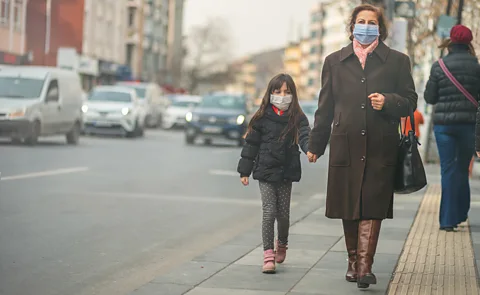How air pollution is causing girls to get their first periods earlier
 Getty Images
Getty ImagesNew research shows that girls in the US are getting their first periods earlier. Exposure to toxic air is partly to blame.
For several decades, scientists around the world have become increasingly concerned by signs that girls are entering puberty at a much younger age compared with previous generations.
From when girls experience their first period, something which scientists term the age of menarche, to commencing breast development, these seminal changes marking the onset of adolescence appear to be taking place progressively sooner.
American girls today have been estimated to start menstruation up to four years earlier compared to girls living a century ago. In May, new data showed that while girls born between 1950 and 1969 typically began menstruating at 12.5 years, this decreased to an average of 11.9 years for the generation born in the early 2000s.
The same trend has also been noted around the world. South Korean scientists have described with some alarm how the number of girls displaying signs of precocious puberty – either breast development or menstruation before the age of eight - increased 16-fold between 2008 and 2020.
"We're also seeing that these decreasing ages at puberty are even more pronounced in lower socioeconomic status groups, and ethnic minority groups," says Audrey Gaskins, an associate professor at Emory University in Atlanta, the US. "This has important implications for long-term health."
Researchers like Gaskins are primarily concerned that beginning puberty earlier might trigger a cascade of events which have far-reaching consequences later in adulthood. Emerging data suggests that it may not only curtail the fertility window, particularly if these women then enter menopause sooner, but shorten their lives. Precocious puberty has been repeatedly associated with a higher risk of diseases ranging from breast and ovarian cancers, metabolic syndromes such as obesity and type 2 diabetes, and cardiovascular disease.
Scientists are still trying to understand why this is the case, but Brenda Eskenazi, professor of public health at University of California, Berkeley, says one theory suggests that if the body's cells are exposed to circulating levels of sex hormones such as oestrogen for a greater period of time, this can increase the risk of tumour development because these hormones stimulate cell growth.
"There's some theories that having a longer window of exposure to hormones increases risk for reproductive cancers," she says.
 Getty Images
Getty ImagesThen there are the possible social consequences. Eskenazi points out that girls who enter puberty earlier are also more likely to become sexually active earlier. "There's a scary situation in the United States when we have the trend of abortion becoming illegal and contraception not being available," she says. "It's going to lead to more unwanted teen pregnancies, so that confluence of factors is very frightening."
But why is child development being accelerated in this way?
From obesity to air pollution
The onset of puberty is dictated by two wide-reaching communication networks in the body known as the hypothalamic-pituitary-adrenal (HPA) and hypothalamic-pituitary-gonadal (HPG) axes. They connect a region of the brain called the hypothalamus which regulates various essential bodily functions from hunger to temperature control, with different hormone-secreting glands.
Gaskins says that until 10 to 20 years ago, scientists assumed that the sole cause of premature puberty was childhood obesity, with proteins produced by fat cells called adipokines playing a role in stimulating the HPA and HPG axes. "It's only recently that people have been like, 'Oh that doesn't explain it all, and there have to be other factors involved,'" she says.
Instead, a number of studies in the past three years have pointed to another, more surprising cause – air pollution.
Much of this research has been done by scientists in South Korea, with Seoul, Busan and Incheon ranking among the world's top 100 most polluted cities according to the IQAir index. A recently published review from Ewha Womens University in Seoul identified a repeated relationship between exposure to various pollutants and earlier onset of puberty.
Some of the major culprits appear to be toxic gases such as sulphur dioxide, nitrogen dioxide, carbon monoxide and ozone, all of which are released into the air either through vehicle emissions or waste produced by manufacturing plants. In 2022, a study from scientists in Poland, a country known for its poor air quality due to the prevalence of coal-burning factories, examined data from 1,257 women, and found a link between greater exposure to nitrogen gases and menstruation occurring before the age of 11.
More like this:
• The untraceable ingredients in skincare products|
Perhaps an even bigger concern is fine particulate matter (PM), particles which are far too small to see, but are released into the air from sources ranging from construction sites to wildfires, power generation plants, vehicle engines and even dusty, unpaved roads. In October 2023, Gaskins and colleagues found that US girls exposed to high amounts of PM2.5 – defined as particles with a diameter of less than 2.5 μm – and PM10, both in their mother's womb and during childhood, are more likely to have their first period at an earlier age.
"PM2.5 particles can enter the bloodstream pretty readily," says Gaskins. "You inhale them into your lungs, and they're not filtered out like some of the bigger particles would be, and they can then reach different organs. We've seen certain PM2.5 particles accumulating in the placenta, foetal tissues, the ovaries, they can get everywhere."
 Getty Images
Getty ImagesStudies using mixtures of particles found in indoor air samples, have shown that the chemicals contained within these fine particles are capable of interacting with the receptors for various hormones involved in development – particularly androgen and oestrogen. This can potentially trigger a chain reaction which leads to the initiation of puberty.
"That was our primary hypothesis, that the girls who had higher exposure to PM2.5 were also exposed to more chemicals that were either mimicking oestrogen or just generally disrupting that HPA axis and its regular signals, prompting the body to go into puberty earlier," says Gaskins.
At the same time, there are likely to be many different factors involved in premature puberty. Gaskins suggests that the emerging evidence relating to PM2.5 and other pollutants is just one example of how harmful environmental chemicals can penetrate the body, stimulating far-reaching hormonal changes. (Read more about how unhealthy air changes your body and mind.)
"Pre-pubertal girls are an interesting group because another major route of exposure to chemicals which disrupt hormonal processes is through personal care products," says Gaskins. "And there's now a lot of companies actively going after that demographic and marketing products to them."
Overall, Eskenazi says that there is still much we don't know about the complex connection between our changing world and how these fluctuations are impacting child development, with the role of factors such as microplastics and even climate change being very much unknown.
"I think we're still just at the tip of the iceberg," she says. "We don't know how a hotter climate is affecting the menstrual cycle or even the role of social factors, pressurising girls to grow up sooner. But this trend is very real, and it could be a multifactorial combination of environmental chemicals, obesity and psychosocial issues which are combining to lower the age of menarche."
--
If you liked this story, sign up for The Essential List newsletter – a handpicked selection of features, videos and can't-miss news, delivered to your inbox twice a week.
